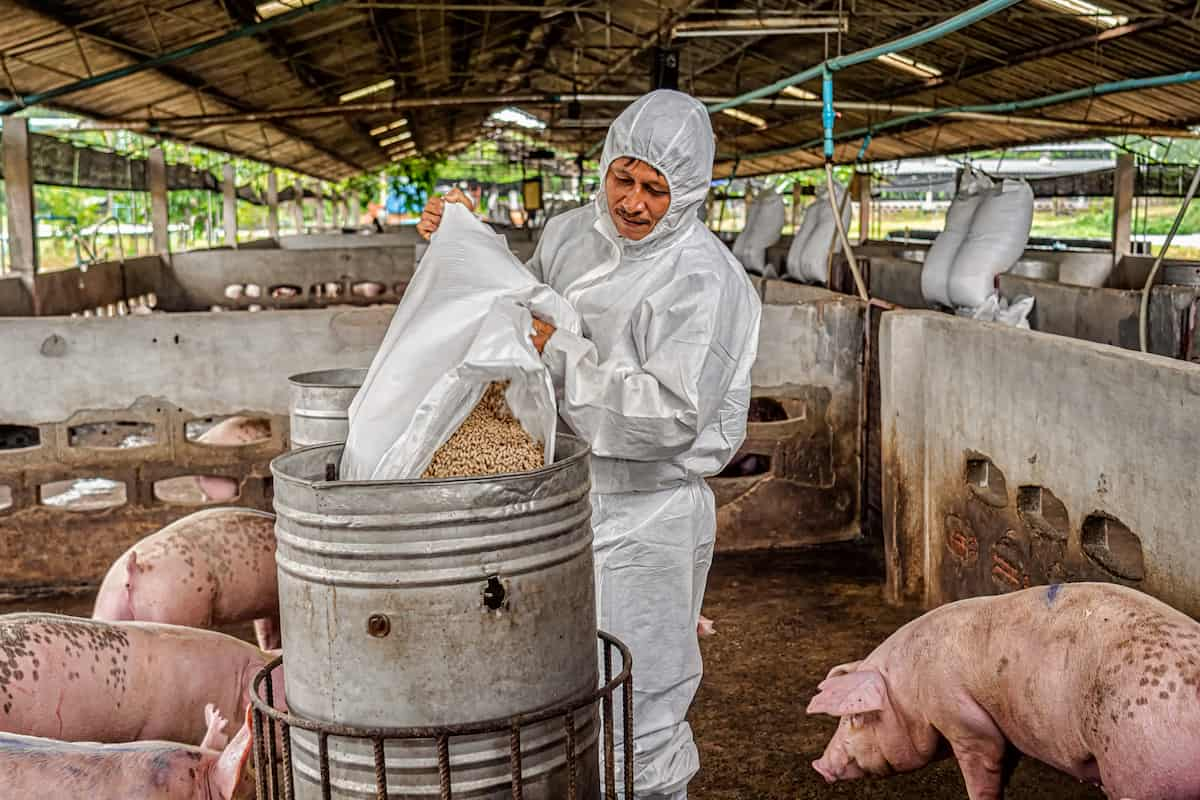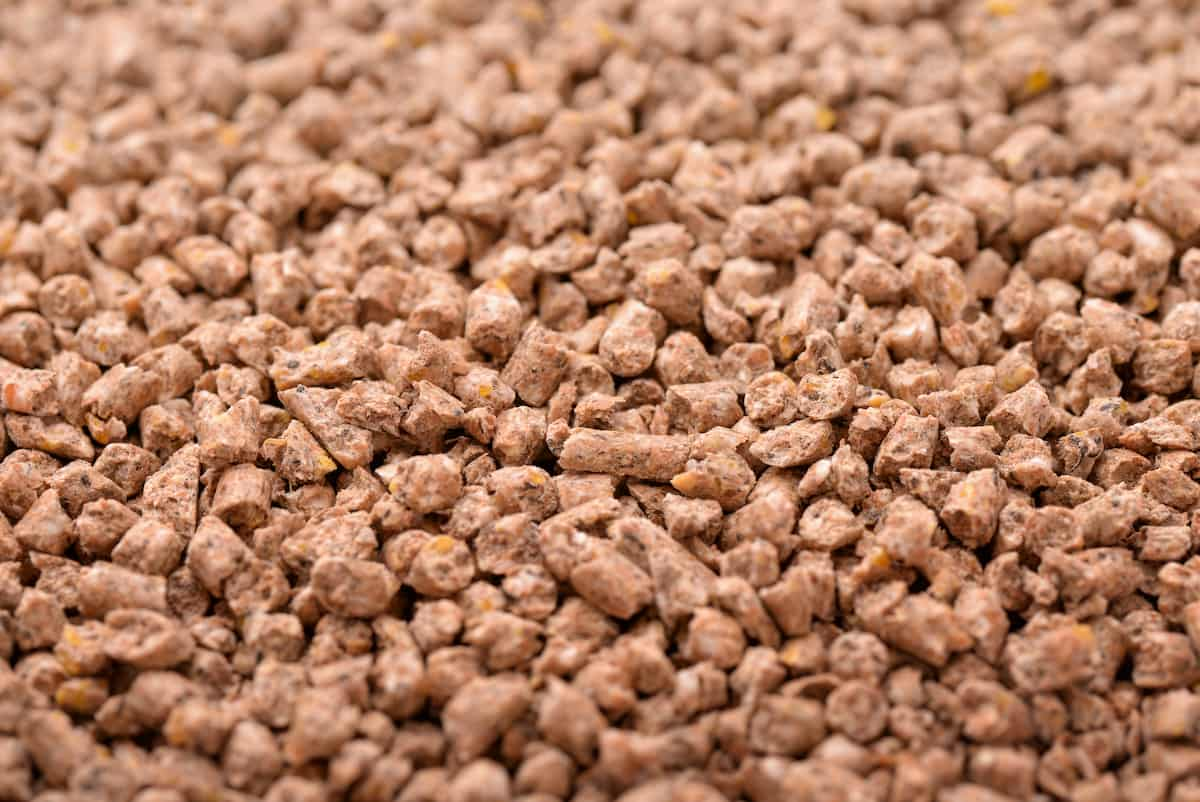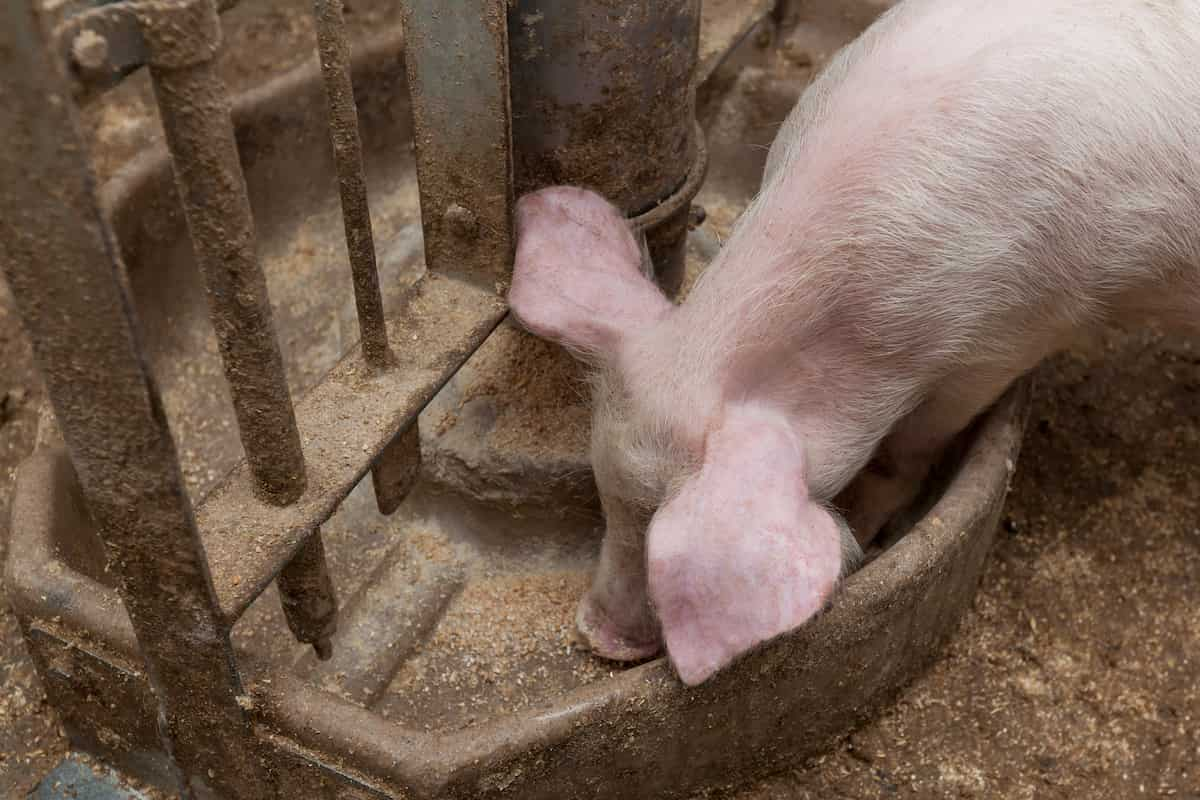Pig performances are related to the quality of the diet and the amount consumed daily by weanlings, growing and finishing pigs, pregnant sows, lactating sows, and their nursing pigs. As part of the overall feeding management process, it is important to know how much feed animals consume. The amount of feed consumed by weanlings, growing pigs, and finishing pigs depends on factors such as diet energy density, temperature, gender, feed quality (e.g., the absence of molds), feeder design, crowding, and other management factors.

Feed Management in Pig Farming
Major Pig Feed Ingredients
Pig producers follow a fundamental economic principle of feeding economic cereal grains and correcting deficiencies by adding high-quality protein sources, minerals, and vitamins. As a result, dependable mineral and vitamin premixes and complete manufactured supplements are available on the market. The most popular diet for pigs is a fortified corn-soybean meal, but other cereals and protein sources can also be used.
Corn (Maize)
Pigs are generally fed corn (maize) as their main grain. The food has a high energy content and is palatable but has a relatively low crude protein content. Additionally, corn lacks lysine, threonine, tryptophan, and several other amino acids, vitamins, and minerals.
Grain Sorghum
Grain sorghum is another major energy source for pigs. The protein content varies depending on factors such as variety, whether the crop was cultivated on irrigated or dry land, the amount of fertilizer used, and other environmental factors. Generally, grain sorghum can be substituted for corn on an equal-weight basis. Still, a poorer feed conversion should be expected because the metabolized energy value is slightly lower than that of corn.
Wheat
It has about the same energy content as corn and contains 2% to 3% more protein and 0.05% to 0.1% more lysine. Wheat can be substituted for corn in an equal-weight ratio. A pig’s diet can be entirely composed of wheat.
In case you missed it: Feed Management in Goat Farming: Feeding Plan, Feed Formula, and Fodder Requirements

Barley
The feeding value of barley is approximately 85%–90% of that of corn, though it usually contains about 2%–3% more protein. The feed of scabby barley to pigs should be avoided.
Oats
The diet should not contain more than 20%–25% of oats due to their relatively low energy content. A diet containing oats is usually expected to reduce gain rates and efficiency. The excellent palatability of rolled oat groats makes them a popular starter food.
Cereal Grains
It is best to grind or roll cereal grains before feeding them to maximize their nutritional value. A medium-fine particle size (550-600 microns) should be achieved for corn and grain sorghum. Grinding wheat coarser (650–700 microns) will prevent it from pasting. Feed conversion is improved through fine grinding, but excessive particle reduction may lead to gastric ulcers.
Mycotoxins should be kept to a minimum in cereal grains. Animal performance can be reduced by aflatoxins, vomitoxin, zearalenone, fumonisins, and other mycotoxins, depending on their level in feed. Breeding animals are particularly susceptible to these toxins.
Soyabean Meal
Pigs are fed soybean meal for more than 90% of their supplemental protein. This product’s amino acid profile complements cereal grains and makes them very palatable. It is possible to feed ground, full-fat soybeans to pigs after they have been heated (by extrusion or roasting) to inactivate trypsin inhibitors and other heat-labile antinutritional factors.
Canola Meal
Canola meal is also an excellent source of protein. Cottonseed, sunflower, peanut, and other oilseed-based meals can be used in pig feed, but they should not be fed as the sole source of protein due to their lower lysine content.
Preparing Feed for Piglets
- Creep Feed is the first and most important dry food for baby piglets. With 20 percent protein, it is fortified with milk by-products and comes in small, chewable pellets that are highly palatable and easy to digest.
- Young, healthy piglets can benefit from this complete feed’s combination of amino acids, vitamins, and protein sources.
- The following ingredients are in descending order in the feed: corn, soya bean meal, barley, wheat bran, vegetable protein, oilseed extracts, fatty acids, feed phosphate, pig vitamins, and trace minerals.
- A good homemade mixture with fine rice bran, broken rice, and milled maize grains can be given to piglets (about 20g per day). There must always be clean drinking water available.
In case you missed it: Beginner’s Guide to Poultry Farming: The Essential Requirements You Need To Know

Daily Feed Requirements for Pigs
- Dry/pregnant Sows and Gilts: A dry sow or gilt requires 2.5 kg of sow and weaner meal daily. The extra 1kg/day should be given one week before and one week after the gilts and sows are served. You should feed lactating sows 2.5 kg of sow and weaner meal a day for maintenance and 0.25 kg extra sow and weaner meal for each piglet they suckle.
- Lactating Sows and Gilts: Lactating sows and gilts require 6 to 6.5 kg of feed daily to meet their energy requirements. To maximize milk production and prevent excessive weight loss in prolific sows, high-protein and amino-acid diets should be fed. It may be necessary to feed such sows a diet high in crude protein, such as 16%–18%.
- Boars: Give a feed of boars 2.0 kg a day. If the boar is consumed, that feed regularly increases to 2.5 kg.
- Piglets: From day seven until the weaning time (21 days), give creep pellets at a rate of 0.5 – 1.0 kg per piglet per day. The feed should be mixed with the weaner and sow meal in the last week before weaning.
- Feeding of Growing and Finishing Pigs: Until they attain an 18 kg live weight, pigs weaned at 3 to 5 weeks with 11 to 13 kg body weight should be fed the starter diet. When a pig reachesseven7 weeks of age, he may be switched gradually to a diet similar to that of a sow or a weaner.
Daily Water Requirements for Pigs
Pigs will reduce their daily feed intake if they do not receive enough water. Your pigs must have access to plenty of clean water at all times. Water can be supplied through the feeding trough. It is common for large farms to use automatic drinkers, which are also known as bowls. All pigs need sufficient clean drinking water, as below,
- A pregnant sow needs 10 to 12 liters of water per day.
- A lactating sow needs 20 to 30 liters of water per day.
- A growing pig needs 6 to 8 liters of water per day.
- A boar needs 12 to 15 liters of water per day.
Conclusion
Pigs grow and get fat more quickly if they are fed concentrated feed. Grain that has been well ground into a meal is a good feed. Waste vegetables and household scraps can also be given to pigs. Household scraps, especially those containing meat, must be well boiled (pig swill) before being given to the pig.
- Feed Your Flock for Less: Top 10 Tips to Save on Chicken Feed
- Ultimate Guide to Ossabaw Island Hog: Breeding, Raising, Diet, and Care
- Hatching Answers: The Top 10 Reasons Your Chickens Aren’t Laying Eggs
- Eggs and Economics: Breaking Down the Cost of Raising Backyard Chickens
- Defend Your Greens: Proven Methods to Keep Iguanas Out of Your Garden
- Ultimate Guide to Cinnamon Queen Chicken: A Comprehensive Guide for Beginners
- Ultimate Guide to California Tan Chicken: Breeding, Raising, Diet, Egg-Production and Care
- Ultimate Guide to Marsh Daisy Chicken: Breeding, Raising, Diet, and Care
- 10 Types of Chicken Farming Businesses You Can Start for Profits
Agriculture/Magazine should continue to help us with credible information to keep us update